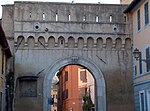Villa Farnesina
1510 establishments in the Papal StatesBuildings and structures completed in 1510Farnese residencesFresco paintings in RomeHouses completed in the 16th century ... and 5 more
Palaces in RomeRaphaelRenaissance architecture in RomeRome R. XIII TrastevereVillas in Rome

The Villa Farnesina is a Renaissance suburban villa in the Via della Lungara, in the district of Trastevere in Rome, central Italy.
Excerpt from the Wikipedia article Villa Farnesina (License: CC BY-SA 3.0, Authors, Images).Villa Farnesina
Via della Lungara, Rome Municipio Roma I
Geographical coordinates (GPS) Address Phone number Website External links Nearby Places Show on map
Geographical coordinates (GPS)
| Latitude | Longitude |
|---|---|
| N 41.893611 ° | E 12.4675 ° |
Address
Villa Farnesina
Via della Lungara 230
00165 Rome, Municipio Roma I
Lazio, Italy
Open on Google Maps








